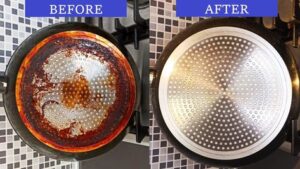Have you ever stared at the stubborn blackened or burnt-on residue on the base of your favorite pot or frying pan, feeling frustrated and defeated? You’re not alone. Cleaning kitchenware can be a chore, but what if there was an easy, effective method that could save you time and effort while restoring your cookware to its former glory? In this article, we’ll explore how to clean the base of pots and frying pans easily using this good method , turning a dreaded task into something quick and satisfying.
Whether you’re dealing with stainless steel, non-stick, or enameled surfaces, this guide will walk you through everything you need to know to get your cookware looking brand new again. Let’s dive in!

Why Is It Important to Clean the Base of Your Cookware?
Before jumping into the cleaning process, it’s essential to understand why maintaining the cleanliness of your cookware is so important. Here’s why:
- Prevent Heat Damage: Burnt food residues can reduce the efficiency of heat transfer, leading to uneven cooking. This means your meals might not turn out as delicious as they could be.
- Maintain Aesthetics: A clean base enhances the look of your kitchen tools and prevents discoloration over time. Imagine serving guests with sparkling-clean cookware—it makes a difference!
- Health Benefits: Removing carbonized particles ensures no harmful substances leach into your food during cooking. Studies suggest that prolonged exposure to burnt residues can pose health risks.
Fun Fact: Regular cleaning extends the lifespan of cookware by up to 50%, according to industry experts. That means less money spent replacing damaged items and more time enjoying your culinary adventures.
What You’ll Need for This Cleaning Method
To achieve spotless results without breaking a sweat, gather these simple yet effective supplies:
Ingredients for Natural Cleaning Solutions
Tools You Can Use
- Non-abrasive scrubbing pad (e.g., Scotch-Brite)
- Soft sponge or cloth
- Old toothbrush for hard-to-reach areas
These everyday household items are affordable, eco-friendly, and highly effective. Plus, they won’t scratch or damage your precious cookware.
Step-by-Step Guide to Clean the Base of Pots and Frying Pans
Now comes the fun part: learning exactly how to tackle those stubborn stains. Follow these steps carefully, and you’ll see amazing results.
1 – Prepare Your Workspace
- Lay out all materials beforehand so you don’t have to scramble mid-cleaning.
- Ensure proper ventilation when working with vinegar or other strong-smelling cleaners. Open a window or turn on the exhaust fan.
2 – Apply the Cleaning Solution
- Sprinkle baking soda generously over the affected area. Make sure to cover every inch of the stain.
- Drizzle white vinegar over the baking soda until it starts fizzing. The reaction between the two creates a powerful cleaning agent.
- Let the mixture sit for 15–20 minutes. During this time, the solution works its magic, loosening even the toughest grime.
3 – Scrub Gently
- Use a non-abrasive scrubber to loosen tough stains. For particularly stubborn spots, sprinkle salt and use a circular motion with a soft sponge.
- If you encounter crevices or corners, grab an old toothbrush. Its bristles can reach places larger tools cannot.
4 – Rinse and Dry
- Thoroughly rinse under warm water to remove all traces of the cleaning solution.
- Dry immediately with a clean towel to avoid water spots or rust. Leaving moisture behind can cause mineral deposits or corrosion over time.
Pro Tip: Avoid steel wool, especially on non-stick surfaces, as it may scratch the coating permanently.

